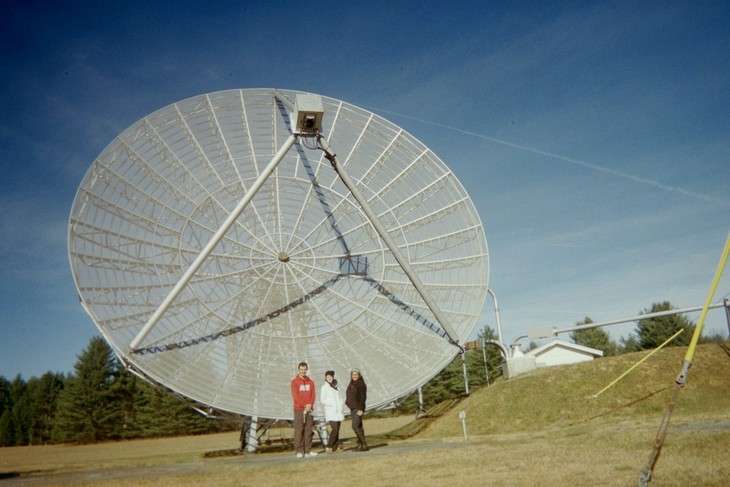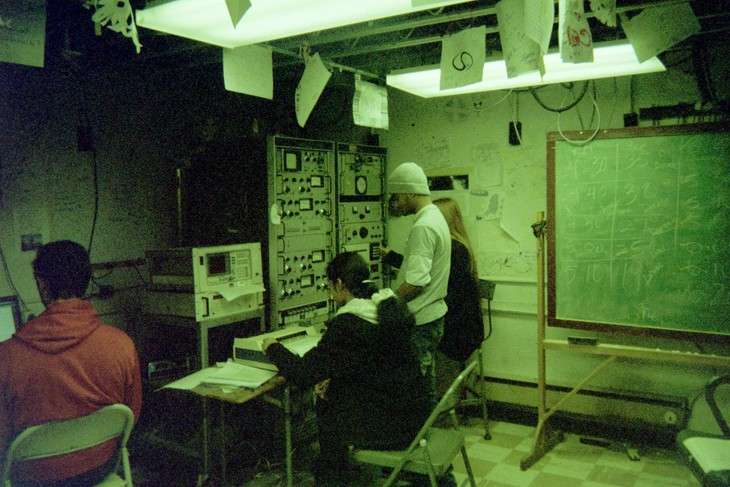Students use steerable radio telescope to study the universe

Penn State Abington students traveled to the National Radio Astronomy Observatory, one of the premier study locations in the world for astronomers, last fall to collect data for their research projects.
Three days in a remote West Virginia mountain town learning to use and tune enormous telescopes led to months of number crunching and sometimes frustrating issues with software and equipment - in other words "a real science experience," according to faculty mentor Ann Schmiedekamp.
"They compared some data from one telescope and realized there were equipment problems and a lot of noise," Schmiedekamp, professor of physics, said. "The software was giving the wrong part of the sky for part of the data acquisition, and the students had to quickly take more data on the robotic scope."
The Green Bank Telescope (GBT) and other radio telescopes enable researchers like the Abington students to detect and study objects in space that give off little visible light but emit naturally occurring radio waves from objects such as pulsars, gas clouds, and distant galaxies. The complex is located inside the National Radio Quiet Zone, a 13,000–square-mile area where most types of electromagnetic radiation on the radio spectrum are banned to minimize disturbance around the home of the world's largest steerable radio telescope.

The Abington students and their two faculty mentors couldn't use cell phones, televisions, or WiFi to avoid skewing data relayed through the highly sensitive equipment. One student said the computer lab, which like the microwave ovens were encased in copper housing, resembled a bank vault.
The Abington student researchers split into three groups:
- The Smith Cloud: The student successfully confirmed the detection of the Smith Cloud, which contains enough hydrogen gas to form a million suns. The Smith Cloud provides a way to study the interaction of dark matter with ordinary matter in the vicinity of our galaxy. The telescope received images that gave a visual of our galaxy and the Smith Cloud. Studies suggest the cloud is composed of dark matter, which is completely invisible to telescopes but emits radio waves.
- Mapping the Universe: The student researchers wanted to map out a portion of the sky and identify radio sources located in it. They directed a remote control telescope at the observatory and used the data to graph small maps of the sky. Abington student Dany Ajlani researched commercial 3D plotting programs, and the students chose SigmaPlot to combine the smaller diagrams and create a large area map using 100,000 data points.
- Hydrogen Absorption Cloud: Working from a 1972 study, the Abington students confirmed its findings of the absorption cloud, and they believe they found some new absorptions in the cloud itself.
Schmiedekamp and her husband, Carl Schmiedekamp, worked with the students throughout the process, accompanying them to the observatory and supporting them when they faced challenges.
"They learned a lot through the data analysis," Ann Schmiedekamp said. "We have some excellent students who have done some very tedious data calculations. They had problems and had to repeat data fitting."
The Abington students and the Schmiedekamps work together through the Abington College Undergraduate Research Activities (ACURA). For the last several years, the duo spearheaded student research trips to the radio astronomy observatory.
The students gathered last week to review their posters and presentations for the annual ACURA poster fair. They present to a panel of judges to determine the winners within each academic division, who then lecture to the campus community at the Fall Colloquium. The winner of the fall lecture may be awarded travel with their faculty mentor to present their findings at a national conference if the work is accepted by the conference's review panel.
More information: Learn more about ACURA: www.abington.psu.edu/ACURA
Provided by Pennsylvania State University





















